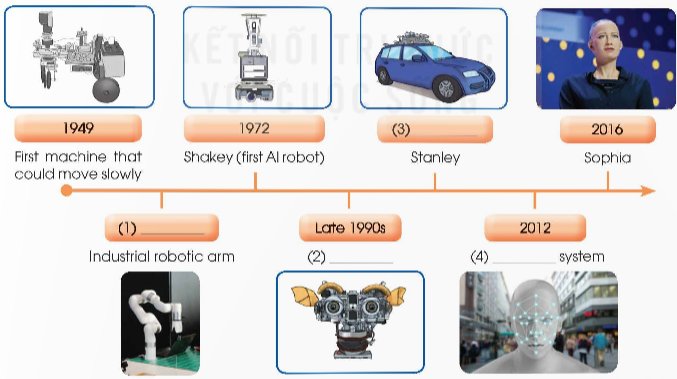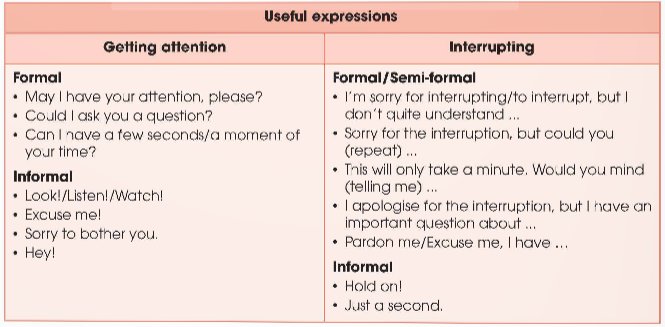Work in pairs. Discuss the following questions.
What types of AI are widely used in Viet Nam? How do you think robots and AI will develop in Viet Nam in the future?
Work in pairs. Discuss the following questions.
What types of AI are widely used in Viet Nam? How do you think robots and AI will develop in Viet Nam in the future?
Read the text and complete the timeline showing the evolution of robots.
THE EVOLUTION OF ROBOTS
The word 'robot' was first used in 1920. It comes from the Czech word 'robota', which means 'forced labour' used in a play by Karel Čapek to describe artificial people.
In 1949, the British inventor William Grey Walter introduced the first machine which could slowly move in response to light stimulus. Ten years later, the first industrial robotic arm was installed at a General Motors plant in the US. Such robots are mostly used in car and computer industries.
The first robot to use Artificial Intelligence was known as Shakey. It was developed at Stanford Research Institute between 1966 and 1972. Shakey could observe its surroundings, create a plan, and find its way across a room or push a box along the floor. Twenty years later, a walking robot called Dante, which was capable of climbing steep slopes, was built to go into active volcanoes. The late 1990s marked a milestone in the history of robots when Kismet, a robotic head designed to provoke and react to emotions, was created.
Since the beginning of the 21st century, more robots have been created to improve our life. The first self-driving car was launched on 8 October 2005 when a Volkswagen Touareg named "Stanley' won a racing competition across the desert. In 2012, the AI expert Geoffrey Hinton and his team created the first accurate visual recognition system.
In 2016, Sophia, a human-like robot was introduced. Sophia can imitate human gestures and facial expressions and is able to answer certain questions and to make simple conversations.
In the future, we may see more robots and AI applications. Whether we accept them or not, they will continue to play an important role in all aspects of our lives.

Thảo luận (1)Hướng dẫn giải
1. 1959
2. Kismet
3. 2005
4. visual-recognition
Hướng dẫn dịch:
SỰ PHÁT TRIỂN CỦA ROBOT
Từ 'robot' được sử dụng lần đầu tiên vào năm 1920. Nó xuất phát từ từ 'robota' trong tiếng Séc, có nghĩa là 'lao động cưỡng bức' được sử dụng trong một vở kịch của Karel Čapek để mô tả con người nhân tạo.
Năm 1949, nhà phát minh người Anh William Gray Walter đã giới thiệu chiếc máy đầu tiên có thể chuyển động chậm rãi khi có kích thích ánh sáng. Mười năm sau, cánh tay robot công nghiệp đầu tiên được lắp đặt tại nhà máy General Motors ở Mỹ. Những robot như vậy chủ yếu được sử dụng trong ngành công nghiệp ô tô và máy tính.
Robot đầu tiên sử dụng trí tuệ nhân tạo được gọi là Shakey. Nó được phát triển tại Viện nghiên cứu Stanford từ năm 1966 đến năm 1972. Shakey có thể quan sát môi trường xung quanh, lập kế hoạch và tìm đường đi qua phòng hoặc đẩy một chiếc hộp dọc sàn nhà. Hai mươi năm sau, một robot biết đi tên là Dante, có khả năng leo dốc, được chế tạo để đi vào những ngọn núi lửa đang hoạt động. Cuối những năm 1990 đánh dấu một cột mốc quan trọng trong lịch sử robot khi Kismet, một đầu robot được thiết kế để kích thích và phản ứng với cảm xúc, được tạo ra.
Kể từ đầu thế kỷ 21, ngày càng có nhiều robot được tạo ra để cải thiện cuộc sống của chúng ta. Chiếc xe tự lái đầu tiên được ra mắt vào ngày 8 tháng 10 năm 2005 khi chiếc Volkswagen Touareg có tên "Stanley" giành chiến thắng trong cuộc thi đua xuyên sa mạc. Năm 2012, chuyên gia AI Geoffrey Hinton và nhóm của ông đã tạo ra hệ thống nhận dạng hình ảnh chính xác đầu tiên.
Năm 2016, Sophia, một robot giống con người đã được giới thiệu. Sophia có thể bắt chước cử chỉ và nét mặt của con người, đồng thời có thể trả lời một số câu hỏi nhất định và thực hiện các cuộc trò chuyện đơn giản.
Trong tương lai, chúng ta có thể thấy nhiều robot và ứng dụng AI hơn. Cho dù chúng ta có chấp nhận chúng hay không thì chúng vẫn sẽ tiếp tục đóng một vai trò quan trọng trong mọi khía cạnh của cuộc sống chúng ta.
(Trả lời bởi Nguyễn Quốc Đạt)
Work in pairs. Use the models in 1 to make similar conversations for these situations. One of you is A, the other is B. Use the expressions below to help you.
1. A is at a museum or robot exhibition where he/she can see B in the crowd, A wants to get B's attention.
2. A is a scientist giving a talk on the use of AI at home. B is in the audience, and he/she wants to interrupt the scientist to ask a question.

Thảo luận (1)Hướng dẫn giải1.
Student A: Hey, Long. Are you also attending the exhibition: Robots in 21st century ?
Student B: Hi, Mai. Yes, I have just arrived.
Student A: Sorry to bother you. Do you want to join me in a VR trip?
Student B: Definitely.
2.
Student A: … So I have talked about the use if AI in education. Now, let’s move to the application of AI in workplace.
Student B: Excuse me, Dr Peter. Would you mind telling me more about the challenges of using AI chatbots in classroom?
Student A: That’s a good question. Well …
Hướng dẫn dịch:
1.
Học sinh A: Này, Long. Bạn cũng đang tham dự triển lãm: Robot trong thế kỷ 21?
Học sinh B: Chào Mai. Vâng, tôi vừa mới đến.
Học sinh A: Xin lỗi đã làm phiền bạn. Bạn có muốn tham gia cùng tôi trong chuyến đi VR không?
Học sinh B: Chắc chắn rồi.
2.
Học sinh A: … Vậy là tôi đã nói về việc sử dụng AI trong giáo dục. Bây giờ, hãy chuyển sang ứng dụng AI tại nơi làm việc.
Học sinh B: Xin lỗi, Tiến sĩ Peter. Bạn có thể vui lòng cho tôi biết thêm về những thách thức khi sử dụng chatbot AI trong lớp học không?
Học sinh A: Đó là một câu hỏi hay. Tốt …
(Trả lời bởi Nguyễn Quốc Đạt)
Listen and complete the conversations with the expressions in the box. Then practise them in pairs.
A. I'm sorry for interrupting B. Do you mind C. Hey D. May I have your attention |
1
Nam: (1) _________, Nick!
Nick: Yes, Nam.
Nam: (2) _________ if I ask you a few questions about our project on robots?
Nick: Not at all. Go ahead.
2
Speaker: (3) _________, please? Today, I'm going to talk about some applications of AI in education.
Phong: (4) _________, but could you please explain the topic of your talk?
Speaker: Sure, we're going to find out how AI can support teachers and students.
Phong: I understand now. Thanks.
Thảo luận (1)Hướng dẫn giải
1. C
2. B
3. D
4. A
Hướng dẫn dịch:
1.
Nam: Này, Nick!
Nick: Ừ, Nam.
Nam: Bạn có phiền nếu tôi hỏi bạn một vài câu hỏi về dự án của chúng tôi về robot không?
Nick: Không hề. Hãy tiếp tục.
2.
Diễn giả: Xin vui lòng cho chú ý được không? Hôm nay, tôi sẽ nói về một số ứng dụng của AI trong giáo dục.
Phong: Tôi xin lỗi vì đã cắt ngang, nhưng bạn có thể giải thích chủ đề cuộc nói chuyện của mình được không?
Diễn giả: Chắc chắn rồi, chúng ta sẽ tìm hiểu xem AI có thể hỗ trợ giáo viên và học sinh như thế nào.
Phong: Giờ thì tôi hiểu rồi. Cảm ơn.
(Trả lời bởi Nguyễn Quốc Đạt)